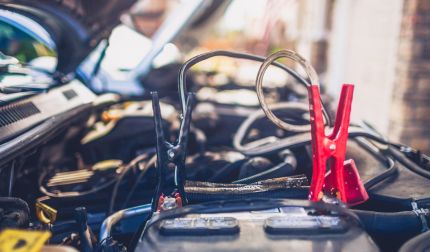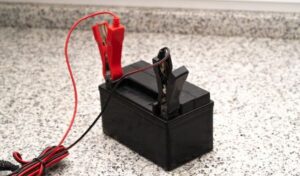Jump starting a car is an essential skill every driver should possess. Picture this: you’re in a rush, you turn the key, and nothing happens. Your automobile battery dies, stranding you. Jump-starting an automobile saves time, money, and frustration. This detailed handbook will ensure your safety and success.
Car batteries—what are they and how do they work? The engine and electrical systems of a car are powered by a rechargeable battery.
It stores chemical energy in the form of electrolytes and releases it as electrical energy when needed.
Identifying vehicle battery parts Know the battery’s main parts to jump start a car. Two terminals—positive (+) and negative (-)—make up the battery. Positive terminals are designated “+” and negative terminals “-“.
Safety precautions before jump starting Before attempting a jump start, it’s crucial to ensure your safety. Park the vehicles on a flat surface away from traffic. Turn off the ignition and all electrical devices in both cars. Put on safety goggles and gloves to protect yourself from sparks and battery acid.
Essential Tools and Equipment
Jump starter cables: types and specifications Jump starter cables, also known as jumper cables, are essential for jump starting a car. They consist of two insulated cables with alligator clips at each end. Ensure the cables are long enough to reach between the batteries of the two vehicles comfortably.
Portable jump starters: pros and cons Portable jump starters are self-contained power units that eliminate the need for a second vehicle. These devices come with built-in cables and a battery pack, providing a convenient and reliable jump starting solution. However, they require regular charging to ensure they are ready when needed.
Battery chargers or other vehicles are alternatives. If you don’t have jump starter cables or a portable jump starter, you can jump start your automobile with a battery charger or another vehicle. A battery charger slowly charges the dead battery, while another vehicle supplies the necessary power. These methods can be helpful, but they require additional equipment.
Preparing for a Jump Start
A. Locating the battery in both vehicles Before connecting the jump starter cables, identify the location of the batteries in both the dead and working vehicles. Most cars have the battery under the hood on one side or near the engine compartment.
B. Assessing the condition of the dead battery Inspect the condition of the dead battery. Check for cracks and leaks. Jump starting a broken battery might be harmful. If so, call a pro or replace the battery.
C. Checking the surrounding environment for safety Ensure there are no flammable materials or open flames nearby. Keep the area well-ventilated to avoid the buildup of potentially explosive gases emitted by the battery. If the battery shows signs of damage or if you detect a strong odor of sulfur, do not proceed with the jump start.
Step-by-Step Guide to Jump Starting a Car
Connecting the jump starter cables properly
- Positive terminals are red or have a “+” symbol, whereas negative terminals are black or have a “-” symbol. Take a moment to familiarize yourself with the battery terminals in both vehicles.
- Attaching the positive (+) cable to the dead battery: Start by connecting one end of the positive (+) cable to the positive terminal of the dead battery. Ensure a secure connection by firmly attaching the alligator clip onto the terminal.
- Connecting the other end of the positive (+) cable to the working battery: Connect the opposite end of the positive (+) wire to the positive terminal of the car with the functional battery.
- Connecting the functional battery’s negative cable: Attach the negative (-) cable to the working battery’s negative connector.
- Grounding the negative (-) cable on the dead vehicle: Find an unpainted metal surface, such as a metal bracket or the engine block, in the engine compartment of the dead vehicle. Connect the other end of the negative (-) cable to this grounding point. Avoid attaching it to the negative terminal of the dead battery, as it can produce sparks.
Starting the vehicles and charging the dead battery
- Negative battery cable: Start-up and revving: Start the working automobile. This helps provide the necessary power to the dead battery.
- Attempting to start the dead vehicle: Now, try starting the engine of the dead vehicle. If it doesn’t start initially, give it a few more tries, but avoid cranking the engine continuously for an extended period. If the engine won’t start, get professional help.
- Letting the vehicles run for a few minutes: Once the dead vehicle starts successfully, let both vehicles run for a few minutes to allow the dead battery to recharge.
Disconnecting the jump starter cables
- Removing the negative (-) cable from the dead vehicle: Begin by removing the negative (-) cable from the metal grounding point in the engine compartment of the dead vehicle.
- Removing the negative (-) cable from the working vehicle: Next, detach the negative (-) cable from the negative terminal of the working battery.
- Removing the positive (+) cable from the working vehicle: Remove the positive (+) cable from the positive terminal of the working battery.
- Removing the positive (+) cable from the dead vehicle: Finally, disconnect the positive (+) cable from the positive terminal of the previously dead battery.
Troubleshooting Common Issues
What to do if the dead vehicle still won’t start If the dead vehicle fails to start even after a successful jump start, there may be underlying issues beyond a dead battery. Consider seeking professional help to diagnose and address the problem.
Dealing with sparks or arcing during the jump start Sparks or arcing can occur when connecting the jump starter cables, which can be potentially dangerous. If you notice sparks, ensure all connections are secure and properly attached. If the issue persists, stop the jump start process and consult a professional.
Safety precautions when handling jump starter cables Always handle the jump starter cables with care to avoid electric shocks and potential hazards. Keep the cables away from moving engine parts, and avoid touching the metal ends of the cables while the engines are running.
After a Successful Jump Start
Allowing the dead battery to recharge After a successful jump start, it’s important to let the previously dead battery recharge. Let the alternator to fully charge the battery by driving the car for 20–30 minutes or leaving the engine running. This helps ensure that the battery has enough power for future starts.
Taking precautions during subsequent starts After jump starting a car, it’s a good practice to be cautious during subsequent starts. Avoid excessive use of electrical devices and try not to make multiple short trips, as this can put additional strain on the battery. Consider having the battery and electrical system checked by a professional to address any underlying issues.
Considering a professional inspection of the battery or electrical system If you frequently experience dead battery issues, it’s advisable to have the battery and electrical system inspected by a qualified mechanic. They can evaluate the battery, identify issues, and fix or replace it.
Frequently Asked Questions (FAQs)
1. Can I jump start a car with a different vehicle?
Yes, you can jump start a car using another vehicle. However, it’s important to ensure that both vehicles have compatible battery systems and that the vehicle providing the jump start has a fully charged battery.
2. Is it possible to damage the vehicles during a jump start?
While jump starting a car is generally safe, there is a small risk of damaging the vehicles if the process is not done correctly. To avoid electrical system damage, cables must be safely connected in the right order.
3. Can I jump start a car without using cables?
Yes, there are alternative methods to jump start a car without using cables. Portable jump starters and battery chargers can be used as standalone options. These devices provide the necessary power to start the vehicle without the need for a second vehicle.
4. How long should I let the vehicles run after a jump start?
It’s recommended to let the vehicles run for at least 20-30 minutes after a jump start. This allows the alternator to charge the dead battery adequately. The duration depends on the battery’s state and power loss.
5. What should I do if my car battery keeps dying?
If you frequently experience a dead battery, it’s important to determine the underlying cause. Several factors, such as a faulty alternator, parasitic battery drain, or an old battery, can contribute to frequent battery failures. Consulting a professional mechanic will help identify the problem and provide appropriate solutions.
Conclusion
In conclusion, knowing how to jump start a car is a valuable skill that can save you from being stranded and provide a quick solution to a dead battery. This article will help you safely and effectively jump start your car. Remember to prioritize safety, take necessary precautions, and seek professional assistance when needed. With this knowledge in hand, you can confidently tackle any unexpected dead battery situation and get your engine running again.






